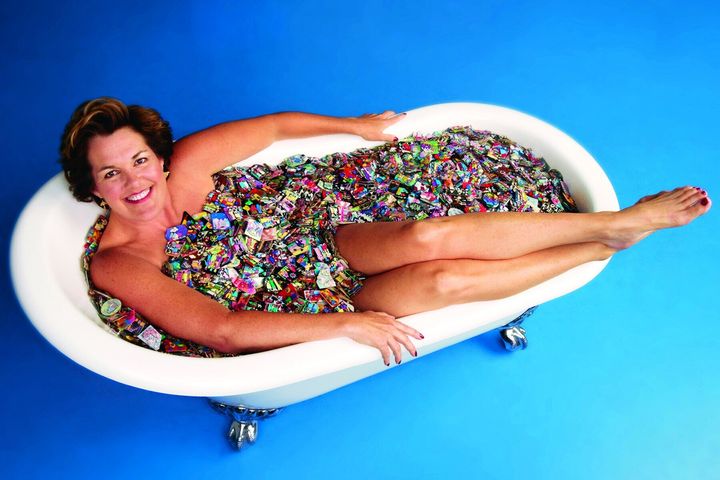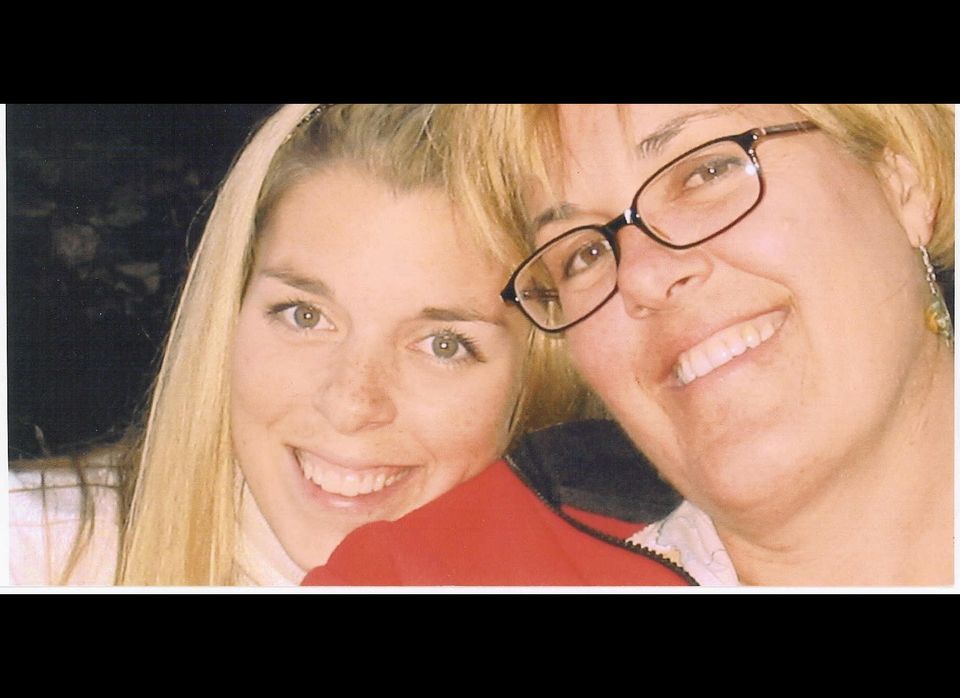
Lucinda Yates' childhood home in Portland, Maine, was the summer hangout for all the neighborhood kids, with whom she would play and plan activities like carnivals for charity. But when Yates was 16 years old, a sudden family tragedy destroyed that idyllic home life -- and by the time she was 25, Yates was living on the streets of California with a 3-year-old daughter.
After surviving a year and a half of homelessness in the early 1980s, Yates moved back to Portland and started putting her life back together by waitressing and selling jewelry part time. But her true breakthrough came in August 1988, when she noticed some colorful mat boards in a frame shop's trash can. She pulled the discarded boards out of the garbage and started cutting them into elementary shapes, eventually creating a pin that looked like a house. Yates sold the pins to a local homeless shelter for $6, which in turn sold the pins for $10 to raise funds.
To date, Designs by Lucinda has sold more than 5 million pins, raising more than $25 million for thousands of nonprofits in the U.S. and globally, as far as Iceland and Malaysia. And though living on the streets was traumatic -- even life-threatening -- Yates acknowledges her life wouldn't be what it is today had she never been homeless in the first place.
What happened between your childhood and your 20s that resulted in you being homeless?
The main thing that disrupted my life is my father died unexpectedly -- just boom, gone -- when I was 16. This left my mom with three girls, one in a wheelchair with cerebral palsy. I was the oldest. Unfortunately, my mom didn't respond well to it. She kind of dropped out of the picture. It was like losing not just one parent, but two. She didn't come around for a couple of years, and by that time, I'd had enough. I ended up going out to the West Coast, and I think I got pregnant the second I was out there and got married very young. Of course, it didn't work, and when we separated, things really unraveled. I was just like my mother. I didn't have any plan, and I wound up living in a van. Then it got worse -- the engine seized and I had to sell the van with everything I had. Back then there were no shelters for women, so I was literally living outdoors. My ex-husband ended up caring for my daughter for a good part of the time, but she was with me sometimes, and it was clear to me that the city park was no place for a child to be calling her living room.
What you were going through emotionally while you were homeless?
It's fearful. You're always looking for where you're going to stay, what's going to be a protected area, where you will be sort of safe. So I slept under bridges, stood in line in soup kitchens -- the whole nine yards. It really is a scary thing. I was held at gunpoint and raped.
Were there ever times like that when you wanted to give up?
Never. To anybody in that situation, I would say, "You have to imagine your next best self." You have to always be thinking, "Where do I see myself in the future?" I never saw myself living there forever. I always wondered, though. I would throw my hands up in the air and look up at the sky and say, "Why is this happening to me? This isn't supposed to be my life. I'm supposed to be living with a knight in shining armor in a house with a white picket fence." I remember feeling so much sadness when I wasn't with my daughter. All I know is I didn't want to be there. I couldn't be there.
How did you try to change your situation?
I used to sit in the city park with other homeless women, who taught me how to craft American Indian beaded jewelry. I'd see mothers walk through the park with their baby carriages and wonder, "Where are they going; where do they live?" And then I thought, "I need to be selling this stuff to them." I would go to a bead store and buy these tiny crystals and incorporate them into the beadwork so when they were laid out in the sun, they would sparkle, and the women couldn't help but look. I sold a few pieces, which meant I could buy some dried fruits or nuts or an occasional cookie and not have to eat at the soup kitchen. I went to a street fair and thought I could sell enough of this jewelry to make enough money for an apartment. I sold like $300 worth of jewelry, but it wasn't enough for an apartment.
So how did you finally manage to get off the streets?
I eventually made it back to Maine and asked my family for help. My mom took me under her wing and gave me shelter. Once you have some stability, you can start putting a life back together. I got a job waitressing, got an apartment and still made jewelry. And one day I thought, "I can be more than a waitress." I was imagining my next best self again. I started these private artist viewings, going into people's homes and showing them my jewelry.
You found your inspiration for your signature house pin in the trash?
I rented a tiny cubby-hole at this custom frame shop. One day I saw all these colorful pieces of mat board coming out of the trash can, and I asked them, "Can I have those?" It must have been a leftover habit from my homeless days. And I cut some shapes out of them and started putting them together into an art deco kind of look. One day I put a triangle on top of a square, and you know what that is -- everyone has drawn that. It's pretty juvenile, but it also holds a lot of meaning for us. It represents security, safety, the American Dream. And a little voice went off in my head: "Wouldn't this make a great fundraiser for the homeless?" That's where it all began.
So you were just putting shapes together? You didn't intend to make a pin of a house?
I wish I was that brilliant. The second I put it together, I knew it didn't look like the type of work I do. I took it to the local shelter and said, "What do you think? We'll raise some money, some awareness for a growing problem that people aren't looking at." They sold them, and a realtor who purchased one called me, wanting to take 100 pins to a convention of realtors. Then I started getting calls from women all over the U.S. saying they wanted to use them to help their local homeless shelters, transitional housing programs, domestic violence shelters. So I decided to put all my eggs in one basket and quit my private artist viewing gig and take a chance on this. I figured, what's the worst that's going to happen -- I'm going to end up homeless again?
How did you grow the company without a formal business background?
I didn't intend to do this. I wish I could say I wrote this business plan, because it's a brilliant plan, from the marketing to having a product that makes a dramatic difference. When I started my company, I couldn't keep up with demand, and the more I couldn't keep up, the more people wanted these things. It was crazy. My first year, I sold $89,000 worth of pins at $6 each. The next year it was $250,000, the next year it was $500,000, the next year it was a million, the next year it was 2 million. It just kept doubling. I truly don't even know how I did it. I had created a product that was viral through word of mouth. It was a piece of jewelry that gave people a way to start a conversation about a serious social issue. This is like the early social media, I swear to God. I never advertised. I didn't have to -- people were just buying these pins, wearing these pins and talking about them. It was ridiculous.
What feedback have you gotten from the homeless people you're helping?
Here in the pin factory, we can get removed from the heart of what's going on, so when someone calls and says, "because of your pins, we've been able to keep our shelter open for a summer and help 100 women have a safe place to stay," it makes me sit up and remember what we're doing.
I was in Peoria, Ill., and got a chance to see the YWCA's shelter program and meet some of the families who live there. Things have changed since I was homeless. The average age of a homeless person in Peoria is 10 years old. It's staggering.
How do you hope to inspire the homeless people you meet?
When they see someone succeed, they can start to imagine that maybe that could be them. The only way you're going to get anywhere, whether you're homeless or not, is when you start to envision something in yourself and really want it. And if that's the message they take away, then they really do have a chance.
From learning to make jewelry from other homeless women to finding the boards in the trash and creating a house pin that helps homeless shelters, it seems like homelessness is a thread that has run throughout your life, even after you were homeless. Do you think some part of that experience of being homeless has always stayed with you?
Are you kidding me? I can't get away from it. Today I was driving to my office, and I had absolute joy from this thought: This is what I love to do. This is my life. It's almost like a destiny thing. There is a thread that runs through it all, and I think it is quite divine.
Entrepreneur Spotlight
Name: Lucinda Yates
Company: Designs By Lucinda
Age: 57
Location: Portland, Me.
Founded: 1989
Employees: 10
2012 Projected Revenue: Undisclosed. Has raised more than $25 million for nonprofits since inception
Website: www.lucinda.com
